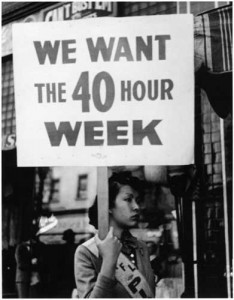SeaTac’s Prop. 1 has policy-wonks and media outlets re-hashing a long standing argument about raising the minimum wage. Although Prop. 1 is not a minimum wage initiative but rather a living wage requirement targeting specific industries; the debate nonetheless has focused on the “minimum.”
Some opinion makers point to a move made in Washington State, in 1998, to index the minimum wage with inflation. As a result, many other states have seen the minimum wage remain stagnant: without adjusting to inflation, a person who earns minimum wage effectively earns less than they did the year before.

However, the state of Washington’s minimum wage has only kept at pace with its original intent – to set a bare minimum rate of payment to prevent blatant abuse of workers. That is all. To put this in context, the Fair Labor Standards of Act of 1938 that established a minimum hourly wage also banned oppressive child labor, and established the 40 hour work week. The minimum wage is exactly that – an absolute bare minimum to halt exploitation.
Yet, even many opponents of raising the minimum wage would agree that the minimum wage is not a livable wage. The minimum wage is a poverty wage.
Let’s examine even the highest minimum poverty wage – $9.19 an hour. This adds up to about $19,100 per year for a full time worker working 2080 hours per year, after the federal income tax, this can be as low as $16,700 in a workers pocket.
In Washington, the average cost of housing, utilities and transportation for one single adult is roughly $16,850 per year. This leaves no room in a single adult’s budget for health care, food or savings. When you add the costs of supporting children, this income becomes even more unsustainable. To get by, households go into debt or utilize other services to make sure their families get the services they need.
This is why the local living wage movement took hold twenty years ago in Baltimore when faith leaders working in homeless shelters and soup kitchens began to realize that many of those who were using their services every single day were people who held jobs. Since 1994, the living wage laws became effective ways for cities and localities across the United States to address poverty and boost their local economies.
However, this movement largely bypassed Washington State. Even though our state has the highest minimum poverty wage, we only have one city with a living wage law on the books – Bellingham. Their policy only covers industries that contract directly with the City of Bellingham.
Proposition 1, which would set a living wage of $15 an hour for certain transportation and hospitality workers in the City of SeaTac would be the second living wage policy in Washington State and one of dozens across the country.
For more information about Prop 1 read our posts on who is covered by the policy and why it is not the highest, nor a minimum wage.
